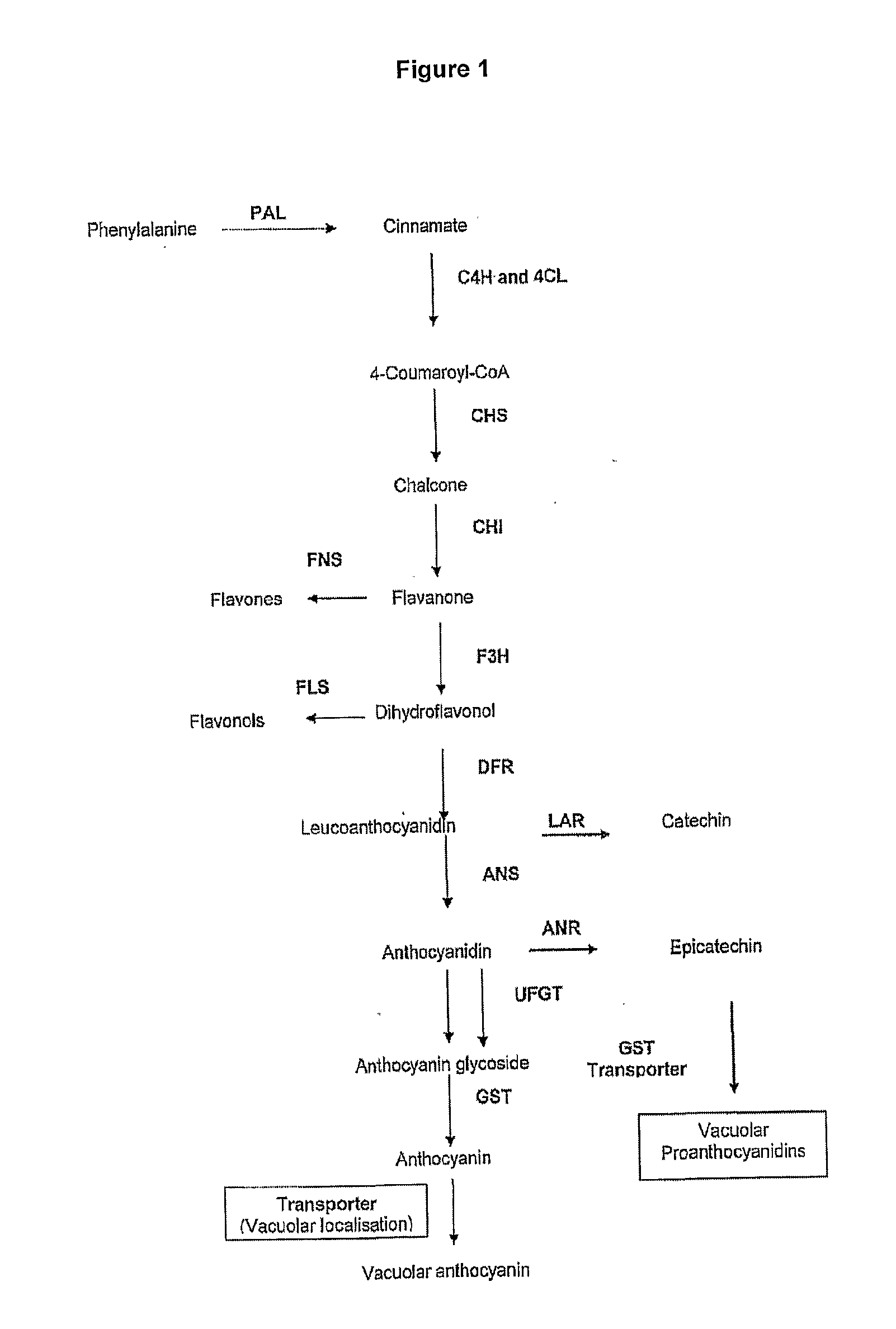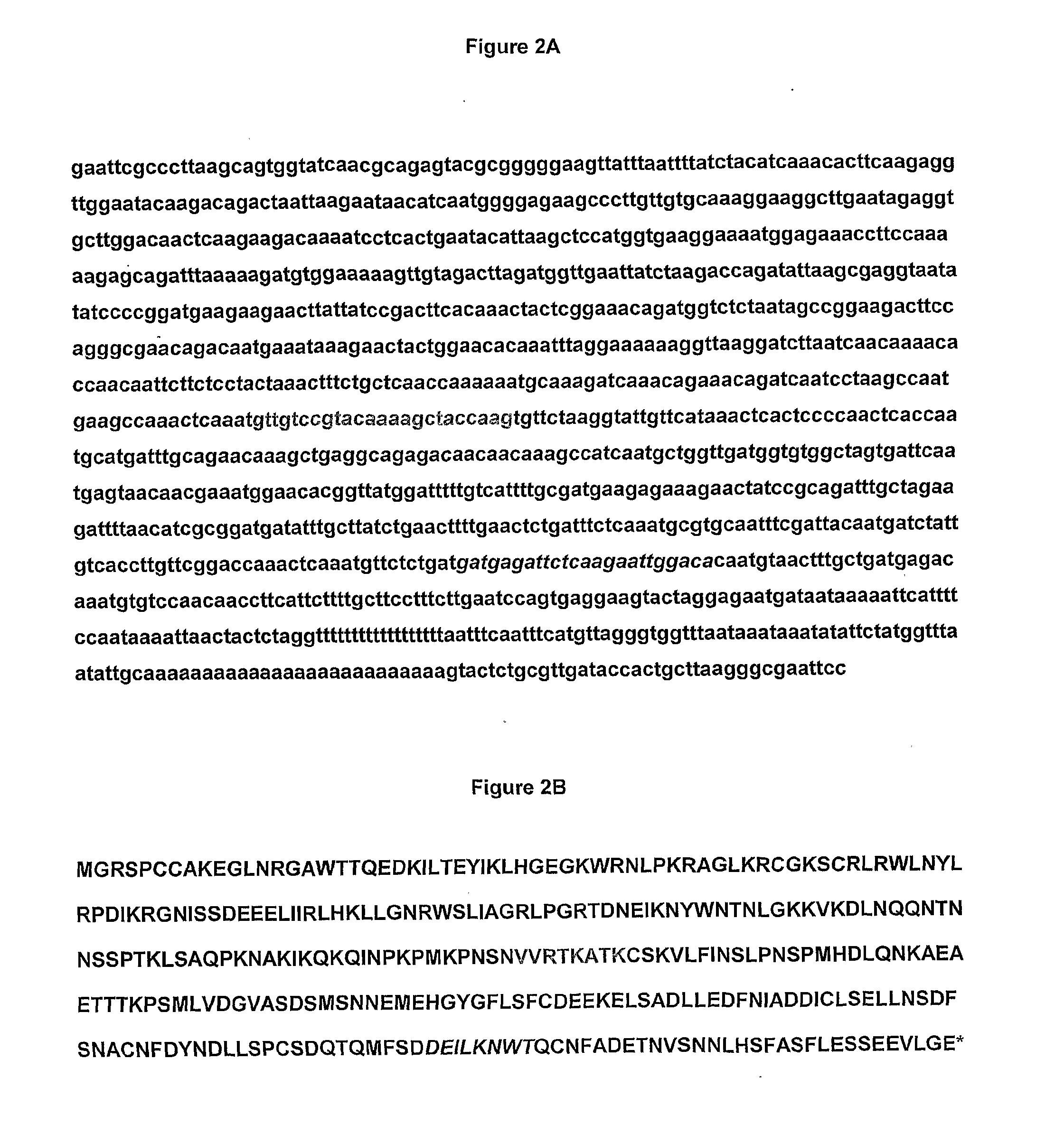Novel genes involved in biosynthesis
- Summary
- Abstract
- Description
- Claims
- Application Information
AI Technical Summary
Benefits of technology
Problems solved by technology
Method used
Image
Examples
example 1
Identification of the MYB14 Genes / Nucleic Acids / Proteins of the Invention, and Analysis of Expression Profiles
Introduction
[0380]Using primers designed to the MYB domain of legume species, the applicant has amplified sequences encoding novel MYB transcription factors (TFs) by PCR of cDNA and genomic DNA (gDNA) isolated from a range of Trifolium species. These species differ in their capacity to accumulate CTs in mature leaf tissue. Because white clover does not express CT genes in leaf tissue the applicants used an alternative strategy that allowed isolation of the expressed MYB TF from closely related Trifolium species (T. arvense; T. affine) which do accumulate CTs in all cells of foliar tissue throughout the life of the leaf. This was achieved by investigating the differential expression patterns of MYB TFs in various Trifolium leaf types; namely (a) within white clover (T. repens) leaf tissue, where CT gene expression is restricted to the leaf trichomes during meristematic develo...
example 2
Use of the MYB14 Nucleic Acid Sequence of the Invention to Produce Condensed Tannins in White Clover (Trifolium repens)
Materials and Methods
Genetic Constructs Used in the Transformation Protocol
[0430]The plant transformation vector, pHZBar is derived from pART27 (Gleave 1992). The pnos-nptII-nos3′ selection cassette has been replaced by the CaMV35S-BAR-OCS3′ selection cassette with the bar gene (which confers resistance to the herbicide ammonium glufosinate) expressed from the CaMV 35S promoter. Cloning of expression cassettes into this binary vector is facilitated by a unique NotI restriction site and selection of recombinants by blue / white screening for β-galactosidase. White clover was transformed using M14ApHZBarP which contains the expressed allele from Trifolium arvense. Over-expression cassettes for M14ApHZBarP were firstly cloned in pART7. The construct were then shuttled to pHZBar as a NotI fragment. T-DNAs of the genetic constructs, showing orientation of cloned genes, are...
example 3
Use of the MYB14 Nucleic Acid Sequence of the Invention to Produce Condensed Tannins in Tobacco (Nicotiana tabacum)
Materials and Methods
Genetic Construct Used in Transformation Protocols.
[0447]The NotI fragment from the plasmid M14ApHZBAR (FIG. 6) was isolated and cloned into pART27 (Gleave, 1992) for transformation of tobacco. This binary vector contains the nptII selection gene for kanamycin resistance under the control of the CaMV 35S promoter.
Tobacco Transformation
[0448]Tobacco was transformed via the leaf disk transformation-regeneration method (Horsch et al. 1985). Leaf disks from sterile wild type W38 tobacco plants were inoculated with an Agrobacterium tumefaciens strain containing the binary vector, and were cultured for 3 days. The leaf disks were then transferred to MS selective medium containing 100 mg / L of kanamycin and 300 mg / L of cefotaxime. Shoot regeneration occurred over a month, and the leaf explants were placed on hormone free medium containing kanamycin for root...
PUM
| Property | Measurement | Unit |
|---|---|---|
| Fraction | aaaaa | aaaaa |
| Volume | aaaaa | aaaaa |
| Volume | aaaaa | aaaaa |
Abstract
Description
Claims
Application Information
 Login to View More
Login to View More - R&D
- Intellectual Property
- Life Sciences
- Materials
- Tech Scout
- Unparalleled Data Quality
- Higher Quality Content
- 60% Fewer Hallucinations
Browse by: Latest US Patents, China's latest patents, Technical Efficacy Thesaurus, Application Domain, Technology Topic, Popular Technical Reports.
© 2025 PatSnap. All rights reserved.Legal|Privacy policy|Modern Slavery Act Transparency Statement|Sitemap|About US| Contact US: help@patsnap.com



